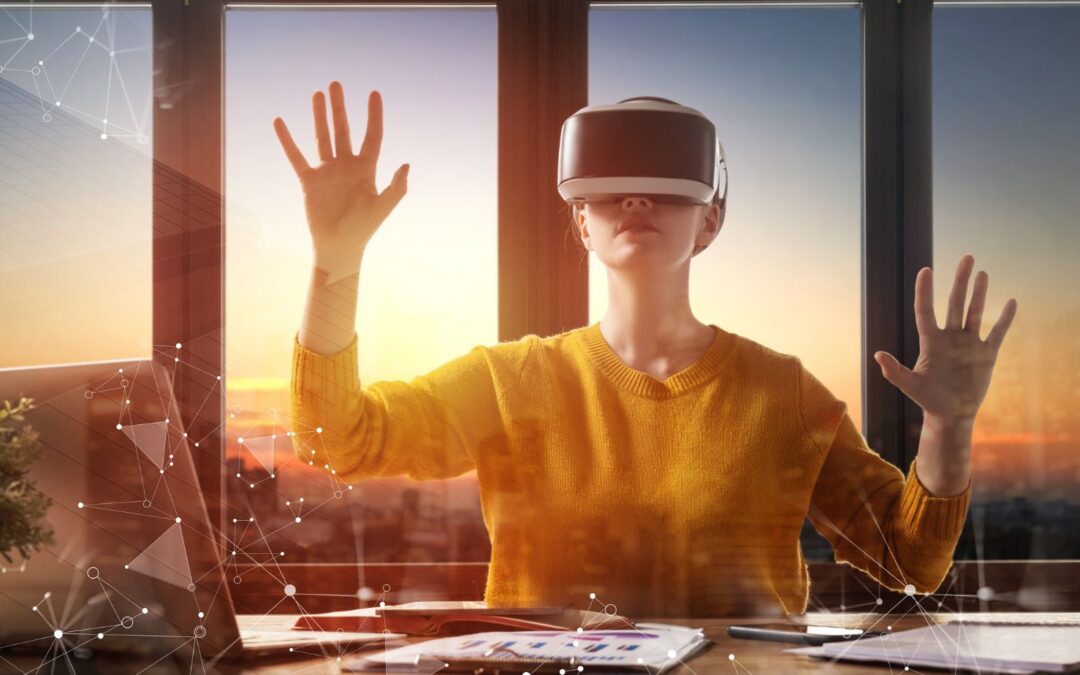The metaverse and web3 are poised to revolutionise the cryptocurrency landscape by offering immersive, decentralised experiences that redefine ownership and value exchange. As virtual environments become increasingly integrated with blockchain technology, the future of cryptocurrency looks to be defined by enhanced user engagement, interoperability, and decentralised finance opportunities within these digital realms.
The Metaverse: A New Virtual Frontier
The metaverse—the space where real and virtual worlds intersect—holds immense potential, transforming the way we interact with cryptostake technology and each other. Picture immersing yourself in a digital realm where lifelike experiences, interactions, and parallel existences come to life. It’s not just about games or videos; it’s a new dimension of living and working, redefining social interactions and economic transactions.
At its core, the metaverse combines elements of virtual reality (VR) and augmented reality (AR), creating a seamless blend of physical and digital realms. In these virtual spaces, users can explore, communicate, work, learn, and even conduct business much like they would in the physical world. The possibilities are truly endless when it comes to the metaverse, offering a dynamic environment that’s continuously evolving.
Creating Unique Digital Environments
In platforms like Decentraland and Roblox, users have the power to craft their own virtual worlds, shaping landscapes, structures, and experiences. It’s akin to building an entirely new reality from scratch, complete with vibrant communities and novel economies. The ability to purchase virtual land and develop it opens up a world of creativity and entrepreneurship.
Participants can establish businesses, host events, or trade virtual assets within these carefully constructed environments. This virtual real estate is not just imaginary—there are actual financial transactions occurring within these spaces, fostering a bustling ecosystem of digital commerce. The metaverse stands as a testament to human ingenuity and technological advancement, where imagination converges with practicality.
In addition to entertainment and recreation, the metaverse introduces new modes of collaboration and productivity. Just as one meets colleagues in a physical office space, individuals can engage in meaningful work interactions within a virtual workspace. This shift marks a pivotal evolution in how we approach professional engagement—a borderless landscape where distance becomes irrelevant, enabling efficient communication across global networks.
The concept of the metaverse transcends traditional boundaries, amplifying our capacity for creativity and connectivity while redefining established norms of socialization and economic exchange. This new virtual frontier stands poised on the brink of revolutionary change.
How Web3 is Shaping Virtual Worlds
In the emerging metaverse, where virtual reality and real life intersect, Web3 is a game-changer. It introduces a new frontier of possibilities, empowering users with greater control over their data and digital assets. Essentially, Web3 operates on decentralized and peer-to-peer networks using blockchain technology. This shift significantly enhances privacy, security, and transparency in virtual environments.
The integration of Web3 technology into these virtual spaces transforms them into decentralized applications (dApps). This means that users now have the capability to own and manage their digital belongings with ultimate autonomy. Unlike traditional systems where centralized authorities hold sway over user data and assets, the decentralized nature of Web3 redefines digital ownership. Through smart contracts built on blockchain networks, users can securely trade, protect, and monetize their virtual possessions without the need for intermediaries.
Imagine stepping into a virtual world within the metaverse, equipped with your unique avatar and an array of digital assets – from virtual real estate to artwork. All these assets are locked into smart contracts on a blockchain network, ensuring that your ownership rights are preserved securely and transparently. As you navigate this immersive space, you have unparalleled control over your identity and possessions. This level of empowerment is a direct result of Web3’s influence on virtual worlds.
Moreover, Web3 facilitates a seamless user experience by offering enhanced interoperability across various virtual platforms within the metaverse. This interconnectedness opens up a multitude of opportunities for users to engage in diverse virtual experiences while maintaining control over their digital footprint.
With Web3, users not only participate actively in shaping the metaverse but also become custodians of their own digital sovereignty. This progressive shift towards decentralization fosters a more equitable and transparent environment within virtual realms.
The impact of Web3’s integration into the metaverse extends beyond revolutionizing digital ownership; it creates a dynamic space where users are empowered to shape their virtual destinies with unprecedented autonomy.
As we venture farther into the convergence of crypto technologies and virtual worlds, we will explore the pivotal role that cryptocurrency plays in shaping vibrant virtual economies.
Role of Cryptocurrency in Virtual Economies
In the world of virtual economies, cryptocurrency is not just a buzzword; it’s an essential part of how virtual transactions take place. Imagine stepping into a virtual mall, browsing through virtual art galleries, or attending a virtual concert – all of these experiences are underpinned by the use of cryptocurrency.
In Decentraland, users rely on MANA, the platform’s native cryptocurrency, to conduct various forms of transactions within the digital universe. This seamless integration of cryptocurrency as a means of financial exchange enables users to purchase digital real estate, invest in virtual assets, engage in commerce, and even participate in social and entertainment events with confidence. Just as you use traditional currency to make purchases in your physical world, MANA works as the digital currency for transactions and investment activities in Decentraland.
Similar to how you would use cash or credit cards to buy goods and services in the physical world, MANA empowers users to seamlessly participate in various interactions and secure their ownership of digital assets. This illustrates the pivotal role that cryptocurrency plays within virtual environments, elevating them beyond pure entertainment to encompass fully functional economies.

Moreover, beyond Decentraland, numerous other virtual platforms have integrated cryptocurrencies to facilitate economic activities. Whether it’s trading digital art, acquiring virtual real estate, or engaging in e-commerce transactions within the metaverse, cryptocurrency serves as the lifeblood that enables these entities to thrive.
By using secure blockchain technology, cryptocurrency ensures that all transactions are transparent, tamper-proof, and efficiently recorded, fostering trust and reliability within these virtual ecosystems.
The implications of integrating cryptocurrency into virtual economies are profound and far-reaching. Beyond just enabling financial transactions, its adoption signifies a fundamental shift in how we perceive and utilize digital assets within evolving online spaces.
Now, let’s examine the underlying framework that makes these secure transactions possible within Web3—a domain where blockchain reigns supreme.
Blockchain: Powering Secure Transactions in Web3
Blockchain technology is the bedrock for the secure and decentralised nature of Web3. Unlike traditional centralized systems, blockchain operates as a distributed digital ledger that chronologically records transactions across multiple computers, ensuring transparency and immutability.
If you’ve ever wondered how sensitive information and financial transactions can be securely managed within the metaverse, blockchain is the answer. The blockchain’s design inherently prevents unauthorised alterations due to its distributed nature. Each block of data is linked using cryptographic principles, creating a chain of transactions that cannot be tampered with.
This distributed ledger technology ensures that every transaction taking place within the metaverse is recorded permanently and accurately. It’s akin to having an incredibly secure vault in cyberspace where every digital asset exchange is diligently tracked and verified.
Decentralisation and Trust
One of the most significant benefits of blockchain within Web3 is the decentralization it offers. By removing the need for a central authority, such as a bank or government, transactions take place directly between individuals or entities with full transparency and security.
The decentralized nature of blockchain fosters trust, as every transaction is validated by consensus among multiple participants on the network. This ensures that no single entity has control over the entire system, reducing the risk of fraud or manipulation.
Blockchain at a Glance:
-
- Ensures the integrity of virtual assets and transactions within the metaverse.
- Records each transaction securely in a decentralized manner.
- Enhances trust and reduces the risk of fraud or manipulation.
In essence, blockchain technology within Web3 acts as a guardian, meticulously safeguarding the integrity and security of virtual assets and transactions. Its decentralized framework instills confidence in users, reinforcing the credibility of virtual economies and paving the way for a new era of secure transactions in the metaverse.
In paving the way for secure transactions, blockchain technology sets the stage for seamless interactions in the metaverse. Let’s now venture into how gaming and socializing are evolving within this futuristic digital realm.
Gaming and Socialising in the Metaverse
The metaverse isn’t just a fancy name thrown around—it’s a platform that’s becoming home to all kinds of experiences that unite people from diverse corners of the world. Imagine stepping into an alternate universe where you’re not restricted by the laws of physics or geography. In this digital domain, you can be anyone or anything you want. The metaverse brings together gamers, creators, and socializers from different backgrounds for shared adventures and fun.
One of the most exciting things about the metaverse is its immersive gaming experiences. 3D environments provide players with an avenue to explore richly detailed and interactive landscapes, where they can interact with objects, other players, and non-player characters (NPCs). Virtual reality (VR) gadgets enrich these gaming experiences, making it feel as if you’re physically present in the game world rather than just watching from a distance.
Moreover, the fusion of blockchain technology in some metaverse games has yielded virtual economies based on digital currencies like non-fungible tokens (NFTs), providing players with unique ownership over in-game assets. This ownership transforms game items into valuable assets, as players can buy, sell, and exchange them within and even outside the game environment.
Take Axie Infinity, for instance—a blockchain-based metaverse game that’s gained widespread popularity due to its play-to-earn model involving adorable creatures called Axies. These Axies are unique NFTs that can be bred, battled, and traded, allowing players to earn real income as they participate in the game’s ecosystem.
In addition to gaming, the metaverse also facilitates social activities. Imagine attending virtual concerts that transcend geographical barriers or participating in events where you can meet new people who share your interests. The metaverse provides an avenue for connection and interaction in ways previously unimagined. Players have begun exploring these digital spaces to combat physical isolation and broaden their social circles.
The potential for socializing in the metaverse goes beyond casual conversations; it extends to conducting business meetings, attending workshops, and even hosting educational seminars. This merging of work and play embodies a future-oriented approach to seamless integration between various aspects of our lives.
As gaming and socializing experience rapid evolution within the metamorphic confines of the metaverse, it’s clear that we are only scratching the surface of its vast potential for engagement and connection.
Now, let’s turn our attention to the groundbreaking advancements driving the rapid transformation of Web3 and its impact on our digital landscape.
Innovation Drive: Notable Developments in Web3
Web3 technology has opened up an array of innovative opportunities across various sectors. One of the most fascinating developments is the rise of non-fungible tokens (NFTs). These unique digital assets have transformed the way we perceive and trade virtual property, artwork, and in-game items, eliminating the need for intermediaries and instead relying on blockchain technology to verify ownership and authenticity.
The impact of NFTs goes beyond mere ownership. At its core, NFTs represent a paradigm shift in how we value digital content. For instance, they allow artists to tokenize their work, creating a new revenue stream by selling digital art directly to collectors. Furthermore, NFTs have also enabled the creation of virtual real estate within the metaverse, where users can purchase and develop virtual land using cryptocurrency.
We’re witnessing unprecedented valuations for digital artworks and collectibles sold as NFTs. Artists who had previously struggled to monetize their digital creations are now finding success through this new medium. Additionally, companies are exploring ways to incorporate NFTs into video games, allowing players to truly own in-game assets with real-world value.
Impact on the Virtual Economy
The creation and trading of NFTs have become a significant driving force in the virtual economy. As a result, entirely new markets centered around digital assets are emerging. The ability to securely buy, sell, and trade these assets using cryptocurrency has led to a reimagining of what constitutes financial transactions within digital spaces.
For instance, virtual land ownership within metaverse environments is becoming increasingly sought after. As demand for these digital properties grows, it’s bringing about an entirely new real estate market where transactions are conducted exclusively through cryptocurrencies.
Moreover, with NFTs permeating various sectors such as art, music, and gaming, we’re witnessing an evolution in how creators can directly engage with their audiences. This direct connection between creators and consumers has paved the way for new business models that promote ownership and interaction over passive consumption.
The emergence of NFTs has undoubtedly ushered in a new era where digital content takes on tangible value while transforming traditional notions of ownership and creativity.
As we continue our exploration of the transformative landscape shaped by Web3 technologies, let’s now navigate towards uncovering the fusion of crypto, metaverse, and Web3 in shaping our decentralized future.
The Decentralised Vision: A Fusion of Crypto, Metaverse, and Web3
Imagine a world where you can buy virtual land using cryptocurrency, design your own digital assets, and then trade them in an entirely digital economy. That’s the vision behind the convergence of cryptocurrency, the metaverse, and Web3 – a decentralized digital landscape that offers users unprecedented autonomy, control, and participation in immersive experiences. This fusion represents a seismic shift in how we interact in digital spaces and build virtual economies.
At its core, this fusion embodies the principle of decentralization – the idea that power and authority should be distributed across a network rather than concentrated in the hands of a few. In this context, it means that users have full ownership of their digital assets. Just like physical possessions, they can buy, sell, or trade these assets without any intermediaries. For example, in the metaverse powered by Web3 technologies, your virtual property rights are secured by blockchain technology, ensuring that your ownership is indisputable.
Consider a scenario where you possess a unique virtual artwork as a non-fungible token (NFT). With this NFT, you have complete control over your artwork – you can display it in virtual galleries, sell it to other avatars for cryptocurrency, or even use it as collateral for virtual loans.
This level of autonomy and flexibility is a game-changer for creators and users alike. It opens up avenues for artists to tokenize their work and earn directly from their creations without traditional gatekeepers.

Furthermore, the decentralized nature of this fusion ensures that virtual economies are not bound by the limitations of centralized control. In Web3-powered metaverses, digital currencies are native to the environment, allowing seamless transactions within the virtual space. Users can engage in commerce, invest in virtual real estate, and participate in novel economic activities using cryptocurrencies tailored for these environments. This emphasizes how crypto is not just a speculative investment but also an integral part of digital interaction.
For instance, imagine attending a virtual concert in the metaverse where you use digital currency to buy exclusive merchandise or support the artist directly through microtransactions.
The combination of cryptocurrency with the metaverse and Web3 fundamentally changes how we conceive of and interact within digital spaces. It marks a departure from centralized control towards user-driven ecosystems where ownership rights are enshrined through blockchain technology. This fusion is not just about technological innovation; it’s about redefining our relationship with digital assets and creating immersive experiences that reflect our increasingly digital lives.
In essence, embracing this vision means embracing autonomy and creative freedom within a truly decentralized digital frontier—a landscape where ownership extends beyond physical boundaries and into the boundless realms of the metaverse. In this rapidly evolving landscape of crypto, the metaverse, and Web3, the possibilities are boundless. Embracing this decentralized vision means embarking on a journey toward redefining our relationship with technology and virtual experiences.
Jessica has a flair for writing engaging blogs and articles. She enjoys reading and learning new things which enables her to write different topics and fields with ease. She also strives to break down complex concepts and make them easy for anybody to comprehend.





